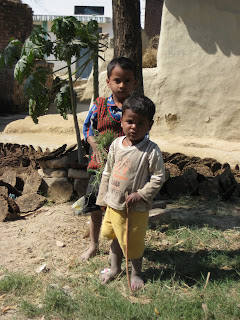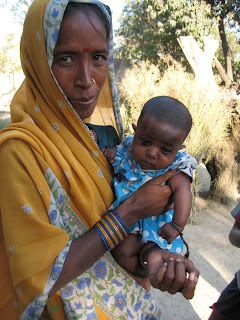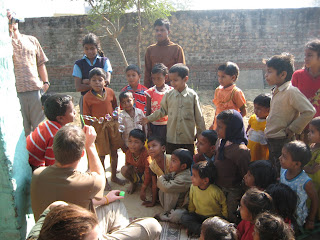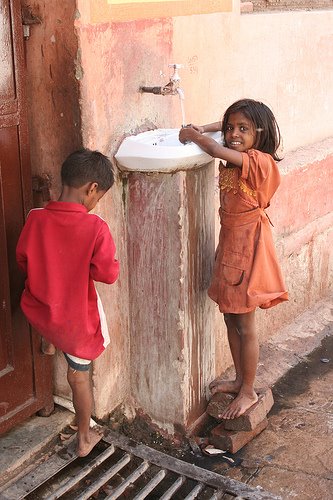While we're here in Chiang Dao we're volunteering in an AIDS orphanage. Established in 1998 by the Sisters of St Paul de Chartes, it serves 60 children -- 44 who are HIV positive and the rest who have been impacted by AIDS, either their parents have died or they were abandoned or brought to the orphanage because their families could no longer care for them.
The facilities at the Baan are both stark and in an odd way, luxurious. The facilities are certainly better than most of the children would be living in in the hill villages around here. Wide open sunlite rooms with tile floors. But the walls are bare and the children sleep in one large room for each gender on mats on the floor. The youngest is three and the oldest is 17. Most seem to be in the 3-10 age range.
The children get retrovirals twice at day and all seem quite healthy. The drugs are free, funded by the Thai government - for all Thai people in fact. Far ahead of US policy! So even when these children leave the orphanage, they will have access to treatment. Some of the children have been adopted by foreigners - Peng showed us a book with many pictures of sweet Thai faces in France, Sweden and Germany. It doesn't seem to be part of the Thai culture to adopt a child not of your family, so most adoptions means the child leaves Thailand.
We walked over to the school to meet the children as they came out of classes = all in their uniforms. They raced up to meet us, climbing in laps and dragging us to see something, all the while chattering in Thai. From what I have experienced, this is not typical of Thai children, although they are far more comfortable with many adults than most American children. (There is a practice here that ALL adults look out for ALL children.) Plong, a little girl about four years old, crawled up into my lap and another little boy wanted to take pictures with my camera. Thank goodness for digital. He loved taking a picture and looking at it.
Other older girls (maybe 9-10) were pushing some of the little ones on a big swing, singing songs that had the cadence of the jump rope songs we sang as kids. One song tumbled into another, and finally they began to sing Chang Chang, the elephant song we learned from Judy Pine before we left. It was fun to join in with them and see the surprise on their faces as we began to sing along in Thai.
Tomorrow I'm going back to work in the school. It will be interesting to see the practices in the classroom. At the end of the day assembly yesterday, all the children lined up in straight rows by class to sing a song and listen to announcements. Far more disciplined and orderly than any middle/high school I've seen.
The high school girls at this school are all boarding students who come from the hill villages. They were all headed for the sex trade industry and were gathered in by the Sisters. Peng says that the incredible poverty in the hill villages makes it an almost impossible situation for the families when there are too many mouths to feed, so this schooling situation is a blessing. Sitting with the 13-17 year old girls with their open smiles and quick laughs, it is hard to think of them as potentially on the streets of Bangkok servicing some foreign tourist. They were curious about us and our lives, asking many questions, each one followed by a quick laugh. Each looking to the others. One young woman had the best command of English, and she asked most of the questions, but looked always to the others for confirmation of the appropriateness of her ideas, and the others offered quick suggestions in Thai.
Finally, the bell rang and all the children left the school yard to gather tools and cleaning equipment to clean the school before leaving for the day. After the grounds and building were cleared, the girls marching band formed and performed for us, including a complicated foot routine and some Thai dancing.
On Friday we will spend time in the village schools near Chiang Dao, then back to Chiang Mai.
More later.
M
 Yesterday we went to witness one of the more bizarre political/social events I have ever seen. Every day, when the border between Pakistan and India is closed for the night, there is a competition between India and Pakistan for who can round up the most spectators and put on the biggest show. There are actual
Yesterday we went to witness one of the more bizarre political/social events I have ever seen. Every day, when the border between Pakistan and India is closed for the night, there is a competition between India and Pakistan for who can round up the most spectators and put on the biggest show. There are actual ly
ly  concrete bleacher built on both sides to seat the crowds who come. These pictures are all from the India side of the border, but although there were fewer people on the Pakistani side, the uniforms were equally as splendid and the roars from the crowd as loud. The whole event was a blend of calls of nationalistic pride, a mosh pit rave and the changing the guard at Buckingham Palace. There were crowd pleasing chants reminiscent of the cheerleading at football games, with one man on India's side leading "Long live Hindustan" while the other side tried to drown the c
concrete bleacher built on both sides to seat the crowds who come. These pictures are all from the India side of the border, but although there were fewer people on the Pakistani side, the uniforms were equally as splendid and the roars from the crowd as loud. The whole event was a blend of calls of nationalistic pride, a mosh pit rave and the changing the guard at Buckingham Palace. There were crowd pleasing chants reminiscent of the cheerleading at football games, with one man on India's side leading "Long live Hindustan" while the other side tried to drown the c rowd out by shouting "Long live Pakistan. Women and children were invited from the crowd to carry flags to the border and back (interesting that no men were allowed. This is the first time I have seen women given a privileged spot, and I wonder if it is because there is concern about what testosterone might spark if the men come face to face across the border. Then the music began to blare and the women and children began to dance in the street that leads to the border, almost a mosh pit rave. Finally the guards themselves came out to close the border, the Indian and Pakistani guards in an obviously choreographed display of fierceness, with very showy marching, music, high stepping and a
rowd out by shouting "Long live Pakistan. Women and children were invited from the crowd to carry flags to the border and back (interesting that no men were allowed. This is the first time I have seen women given a privileged spot, and I wonder if it is because there is concern about what testosterone might spark if the men come face to face across the border. Then the music began to blare and the women and children began to dance in the street that leads to the border, almost a mosh pit rave. Finally the guards themselves came out to close the border, the Indian and Pakistani guards in an obviously choreographed display of fierceness, with very showy marching, music, high stepping and a  ceremony that brought the two flags down exactly at the same time. Then the gates were closed for the night, and the truckers lined up on either side of the border settled down to drink chai, gossip with each other and sleep in their cabs until the border opens again in the morning. It's hard to believe that this circus happens every day with hundreds of people showing up on both sides, but we're told it does. Perhaps this event diffuses some of the tensions that this region has been steeped in since the partition in the 1940s. Can you imagine an event like this at the US/Canadian border?
ceremony that brought the two flags down exactly at the same time. Then the gates were closed for the night, and the truckers lined up on either side of the border settled down to drink chai, gossip with each other and sleep in their cabs until the border opens again in the morning. It's hard to believe that this circus happens every day with hundreds of people showing up on both sides, but we're told it does. Perhaps this event diffuses some of the tensions that this region has been steeped in since the partition in the 1940s. Can you imagine an event like this at the US/Canadian border?



































